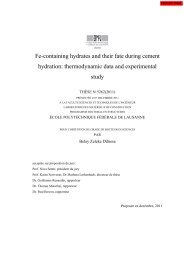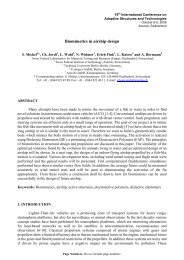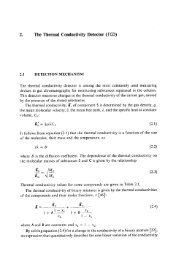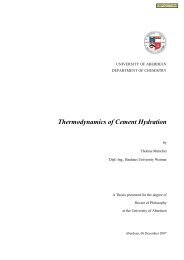Stripe and ring artifact removal with combined wavelet — Fourier ...
Stripe and ring artifact removal with combined wavelet — Fourier ...
Stripe and ring artifact removal with combined wavelet — Fourier ...
You also want an ePaper? Increase the reach of your titles
YUMPU automatically turns print PDFs into web optimized ePapers that Google loves.
are represented by a set of <strong>wavelet</strong> functions Ψl(t) <strong>and</strong> their coefficients at l = 1,···,L different<br />
scales, yielding<br />
f(t) = <br />
L <br />
cL,n · ΦL,n(t)+ dl,n · Ψl,n(t) (4)<br />
n<br />
For a given set consisting of one scaling function ΦL,n <strong>and</strong> a few <strong>wavelet</strong> functions Ψl,n(t) <strong>and</strong><br />
its translated versions, f(t) will be represented by the low frequency coefficients cL,n at the<br />
scale of level L, <strong>and</strong> by the high frequency coefficients dl,n at the scales of l = 1,···,L.<br />
Due to the reduction of the number of coefficients by a factor of two after each decomposition<br />
step, <strong>wavelet</strong> functions Ψl,n are attributed <strong>with</strong> dyadic values. In this way, all <strong>wavelet</strong>s Ψl,n can<br />
be derived from a so called mother <strong>wavelet</strong> Ψ0 <strong>with</strong><br />
Ψl,n(t) = 2 −l/2 · Ψ0<br />
l=1<br />
n<br />
<br />
t − 2l · n<br />
In the case of a discrete signal f(ti), dyadic, decimated <strong>wavelet</strong> analysis can be implemented<br />
<strong>with</strong> the help of quadrature mirror filters, as proposed by Mallat [23], by successively splitting<br />
the input signal into a low frequency <strong>and</strong> a details b<strong>and</strong> by applying a low pass <strong>and</strong> a high<br />
pass filter, respectively. The resulting <strong>and</strong> downsampled low pass b<strong>and</strong>, which represents the<br />
approximation coefficients at a coarser scale, is successively decomposed in the same way by<br />
filte<strong>ring</strong> at the next scale. The set of low <strong>and</strong> high pass filters at different scales is called a filter<br />
bank. The data flow of a 1D multiscale <strong>wavelet</strong> decomposition is sketched in Fig.2.<br />
Fig. 2. A multiscale <strong>wavelet</strong> decomposition is the successive fragmentation of the previous<br />
low frequency b<strong>and</strong> signal into its high <strong>and</strong> low frequency b<strong>and</strong>s by using a high pass (a)<br />
<strong>and</strong> a low pass function (b), <strong>and</strong> successive downsampling (c) of the coefficients on each<br />
b<strong>and</strong> by a factor of 2, in order to preserve the total number of coefficients, which is 1024<br />
for this example.<br />
Looking at a single scale <strong>wavelet</strong> decomposition step of a 2D signal by using filter banks,<br />
the signal f(x,y) is decomposed into a set of four coefficient b<strong>and</strong>s cl, ch, cv, cd, where cl is the<br />
low pass b<strong>and</strong>, <strong>and</strong> ch, cv, cd the horizontal, vertical <strong>and</strong> diagonal details b<strong>and</strong>s, respectively.<br />
#108296 - $15.00 USD Received 5 Mar 2009; revised 9 Apr 2009; accepted 30 Apr 2009; published 6 May 2009<br />
(C) 2009 OSA 11 May 2009 / Vol. 17, No. 10 / OPTICS EXPRESS 8571<br />
2 l<br />
(5)
















